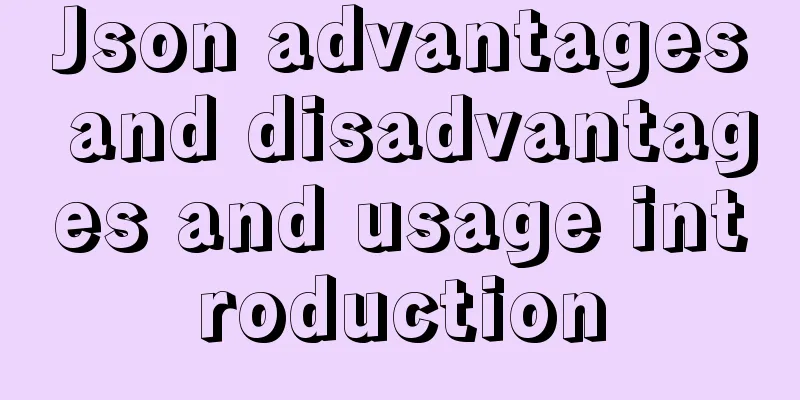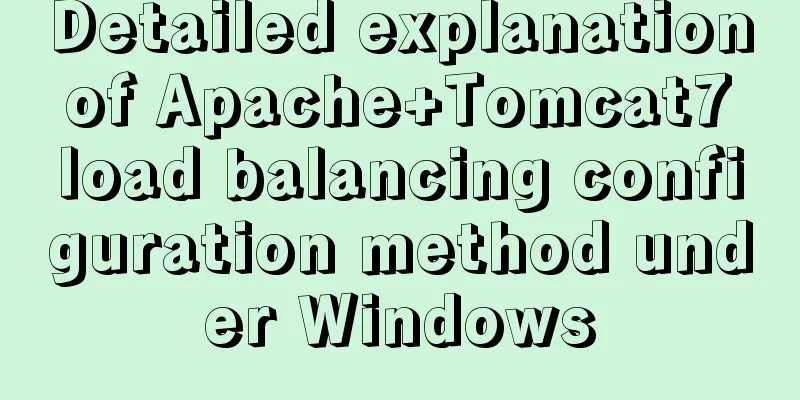Json advantages and disadvantages and usage introduction

1. What is JSONThe concept of JSON is very simple. JSON is a lightweight data format based on a subset of JavaScript syntax, namely array and object representation. Since javascript syntax is used, JSON definitions can be included in javascript files and accessed without additional parsing through XML-based languages. But before using JSON, it is important to understand the special syntax of array and object literals in JavaScript. 1.1 Array literalsAn array literal is a set of comma-separated JavaScript values enclosed in square brackets, for example: var aNames=["hello", 12, true , null]; 1.2 Object literalsObject literals are defined by enclosing two curly braces. Any number of name-value pairs can be placed within the curly braces, defining the format string value. Except for the last line, each name-value pair must be followed by a comma (this is somewhat similar to the definition of an associative array in Perl). For example:
var oCar = {
"color": "red",
"doors" : 4,
"paidFor" : true
};1.3 Mixed LiteralsWe can mix object and array literals to create an array of objects, or an object containing an array. For example:
{comments:[
{
id:1,
author:"someone1",
url:"http://someone1.x2design.net",
content:"hello"
},
{
id:2,
author:"someone2",
url:"http://someone2.x2design.net",
content:"hello"
},
{
id:3,
author:"someone3",
url:"http://someone3.x2design.net",
content:"hello"
}
]};1.4 JSON SyntaxIn Ajax applications, the server directly generates JavaScript statements, and the client directly uses the eval method to obtain the object, thus eliminating the performance loss of parsing XML. At the same time, the benefit of using JSON as a data format in JavaScript communication is that the value of the data can be obtained immediately, so the data contained therein can be accessed faster.
var oCarInfo = eval("(" + sJSON + ")");Remember: curly braces are also a statement in JavaScript. The only way for the parser to know that the curly braces represent an object rather than a statement is to find the parentheses enclosing them (which are used to indicate that the code is an expression rather than a statement). 1.5 JSON encoding and decodingAs part of the JSON resource, Corockford developed a tool that enables direct decoding and encoding of JSON and Javascript objects. The source code of this tool can be downloaded from https://github.com/douglascrockford/JSON-js. There are some inherent deficiencies with using eval() mentioned above: it is designed to evaluate any JavaScript code passed in, not just JSON. Therefore, it has great security risks when it comes to enterprise-level web application development. To solve this problem, you can use the JSON.parse() method, a parser that only converts JSON code into Javascript. For example: var oObject = JSON.parse(sJSON); It also provides a tool for converting Javascript objects to JSON strings (used for data transmission) (there is no built-in support for this in Javascript). All you have to do is pass the object into the JSON.Stringify() method. Take a look at the following example:
var oCar = new Object();
oCar.doors = 4;
oCar.color = "blue";
oCar.year = 1995;
oCar.drivers = new Array("Penny", "Dan", "Kris");
document.write(JSON.stringify(oCar));This code will output a JSON string like the following:
{"doors" : 4, "color" : "blue", "year" :1995, "drivers" : ["Penny", "Dan" , "Kris"]}2. JSON vs XMLAs mentioned above, one of the big advantages of JSON over XML is that it is much simpler. See the XML data representation example: Using XML representation: <comments> <comment> <id>1</id> <author>someone1</author> <url>http://someone1.x2design.net</url> <content>hello</content> </comment> <comment> <id>2</id> <author>someone2</author> <url>http://someone2.x2design.net</url> <content>someone1</content> </comment> <comment> <id>3</id> <author>someone3</author> <url>http://someone3.x2design.net</url> <content>hello</content> </comment> </comments> Using JSON representation:
{comments:[
{
id:1,
author:"someone1",
url:"http://someone1.x2design.net",
content:"hello"
},
{
id:2,
author:"someone2",
url:"http://someone2.x2design.net",
content:"hello"
},
{
id:3,
author:"someone3",
url:"http://someone3.x2design.net",
content:"hello"
}
]};It is easy to find that a lot of redundant information is missing. Since there is no need for a closing tag to match the opening tag, the number of bytes required to transmit the same information is greatly reduced. Founder Corockford calls it "XML's diet plan"). The disadvantage of JSON formatted data compared to XML is that it is less readable for laymen. Of course, there is a point of view that data exchange formats are not meant to be seen with the naked eye. If the data is being created and parsed back and forth by tools, there's really no reason that the data has to be human-readable. The bottom line is this: there are JSON tools available. 3. Server-side JSON toolsjava: java JSON tool, developed by Douglas Crock ford, can be downloaded from https://github.com/stleary/JSON-java, which can be used in JSP. 4. JSON advantages and disadvantagesJSON not only reduces the performance and compatibility issues brought about by XML parsing, but is also very easy to use for JavaScript. It can conveniently obtain data by traversing arrays and accessing object properties. It is also readable and basically has the properties of structured data. I have to say it is a very good method, and in fact Google Maps does not use XML to transfer data, but uses JSON. Another advantage of JSON is its cross-domain feasibility. For example, it is completely feasible to use it on a web page at www.xxx.com, which means you can transmit information across domains. However, using XMLHttpRequest cannot obtain cross-domain information, which is limited by the internal security nature of Javascript. JSON looks beautiful, can it completely replace XML? This is not the case, and the reason lies in XML's strength: universality. It is not easy to make the server generate grammatically qualified JavaScript code. This mainly happens in larger systems where there are different developers on the server and client sides. They have to negotiate the format of the object, which can easily lead to errors.
js to refresh this page: The above is the full content of this article. I hope it will be helpful for everyone’s study. I also hope that everyone will support 123WORDPRESS.COM. You may also be interested in:
|
<<: Interactive experience trends that will become mainstream in 2015-2016
>>: Solution to forgetting mysql database password
Recommend
A brief discussion on Axios's solution to remove duplicate requests
Table of contents 1. Cancel duplicate requests 2....
HTML basic structure_Powernode Java Academy
Many times when learning web page development, th...
Example operation MySQL short link
How to set up a MySQL short link 1. Check the mys...
CSS eight eye-catching HOVER effect sample code
1. Send effect HTML <div id="send-btn&quo...
MySQL5.7.17 winx64 installation version configuration method graphic tutorial under Windows server 2008 r2
Install mysql5.7 under win, for your reference, t...
A brief analysis of Vue's asynchronous update of DOM
Table of contents The principle of Vue asynchrono...
MySQL 5.7.19 installation and configuration method graphic tutorial (win10)
Detailed tutorial on downloading and installing M...
Example of using HTML+CSS to implement a secondary menu bar when the mouse is moved
This article introduces an example of using HTML+...
MySQL5.7.03 Replacement of higher version to MySQL 5.7.17 Installation process and solutions to problems found
1. How to install? 1. [Run] -> [cmd] to open t...
Detailed explanation of how to select all child elements using CSS
How to recursively select all child elements usin...
Sample code for displaying reminder dots in the upper left or upper right corner using CSS3
Effect picture (if you want a triangle, please cl...
How to use vue3+TypeScript+vue-router
Table of contents Easy to use Create a project vu...
Detailed explanation of the pitfalls of mixing npm and cnpm
Table of contents cause reason Introduction to NP...
Docker containers communicate directly through routing to achieve network communication
Overview As for the current default network of Do...
js and jquery to achieve tab status bar switching effect
Today we will make a simple case, using js and jq...









